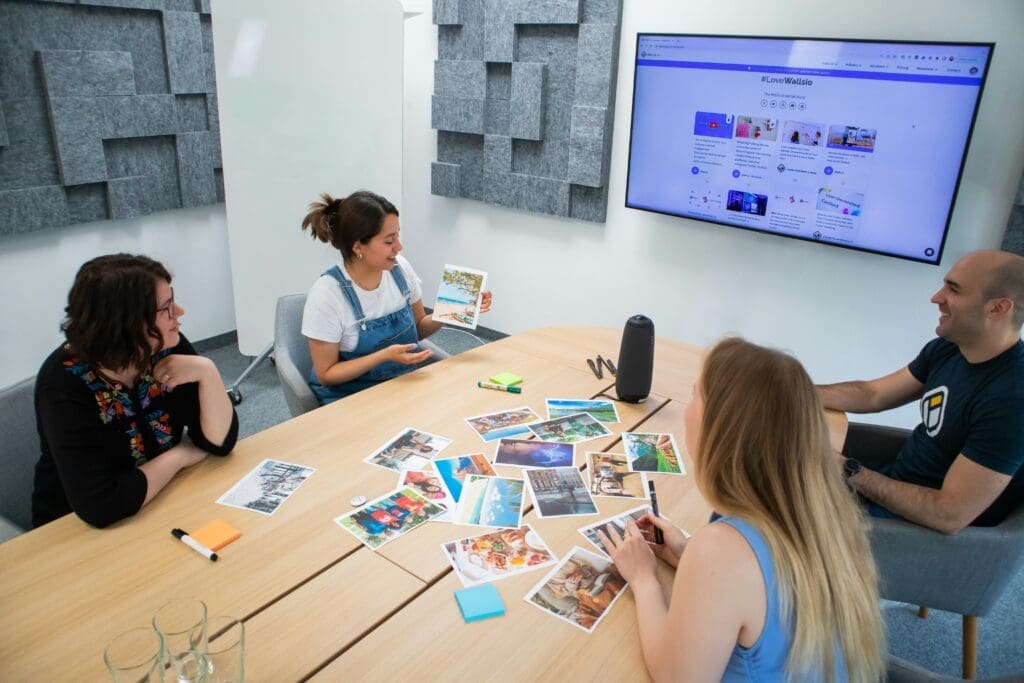Everyone knows that a strong company consists of strong team members who can work together towards a common goal. This goal cannot be achieved without the employees working hard to support each other and having each other’s back when needed.
However, you cannot expect to put a group of random people together in a room and expect them all to get along immediately and work together efficiently. How can people be expected to come up with innovative ideas if they aren’t connected to their fellow employees for support? Studies have shown that the number one thing that people enjoy about their job is their fellow employees. This is why team-building games and other employee engagement activities are so important and necessary for success!
What is Employee Engagement?

Employee engagement is the act of facilitating ways for your staff to interact with each other in a meaningful way. When employees are engaged with one another through games, creative activities, or other team-building activities, they will begin to build a stronger level of trust and rapport with each other. In order to have engaged employees, you need to help bring them together and games are a great way to do that.
Why is Team Engagement & Team Building Important?

Effective team-building games are not only fun, but they also build trust, encourage communication, and mediate conflict. All of this is crucial for effective company culture and boosting job satisfaction. The most effective and memorable team-building games are those that take you out of the redundancy of a day at the office. Spending time together playing a fun game to get to know each other’s strengths and weaknesses will only increase productivity in the long run while bonding and creating relationships.
Who Should Utilize Team Building & Engagement Activities?

Team building & employee engagement activities can benefit anyone, from big corporate companies to groups of friends to volunteers to families. Corporations use employee engagement activities all the time to facilitate collaboration and encourage out-of-the-box thinking. These traits will, in turn, increase employee engagement, boost morale, and employee satisfaction. An employee engagement activity would be a perfect icebreaker for a group of volunteers who might not know each other well but all have the same goal in mind. Distant family members or groups of friends would also benefit greatly from a team-building game to bond and develop stronger relationships.
Fun Employee Engagement Activities & Games
Keep reading to learn some easy and fun employee engagement activities for both in-person and remote employees. We’ve broken it down by how long the games take so that you can implement these engagement activities no matter how much free time you have.
10 Minutes or Less Employee Engagement Activities

1. Game of Possibilities
Rules: Each person in the group is given an object. One at a time, everyone goes in front of the group to act out that object in charades style without speaking. The rest of the group has to guess what object the person is demonstrating.
Objective: To get individuals more comfortable presenting in front of the group and to get team members to work together to come to a conclusion.
Time: 5-6 minutes
Number of Participants: One or multiple small groups
Tools Needed: Any random objects
2. Who Said What?
Rules: Select a game leader and pick a category (favorite movie, musician, food, etc.). Have everyone whisper their answer to the leader who will write them down. The leader will then read out all of the answers. Participants will have to write down who they think said what. Whoever gets the most answers correct wins!
Objective: This task will allow team members to think about their co-worker’s personalities and learn more about one another.
Time: 5-10 minutes
Number of Participants: Any
Tools Needed: Pens and paper
3. Swift Swap
Rules: The participants will form two equal and parallel lines facing each other. They will be given 15 seconds to observe the line across from them. The game will begin when one line completely turns around and faces the other way. Once their backs are turned, the team that did not turn around will have 45 seconds to change 10 things about their group. This can be anything from swapping clothing, changing hairstyles, or making minor accessory changes. After 45 seconds, the first group will turn back around and will try to find all 10 changes. Once the team finishes their guesses, the teams will switch and the other team will have a chance to make the 10 changes. The team who guesses the most correct changes or does it in the fastest time (if they both guess all ten correctly) will win.
Objective: This is a great team-building activity to get the teams working together and communicating while using their memories and creativity.
Time: 5-10 minutes
Number of Participants: 10-20 participants
Tools Needed: None
4. The Strongest Bridge
Rules: The group must pair up with similarly sized teammates. Each pair will have to face each other with their elbows bent, hands up and palms facing toward each other. They will place their palms together and lean towards one another so they will eventually be holding each other up. Slowly, each pair will be instructed to move their feet back further and further. Eventually, they will have to solely depend on one another to remain standing. The group standing the furthest distance apart with their feet wins.
Objective: The objective of this activity is to promote trust and cooperation among team members.
Time: 5-10 minutes
Number of Participants: Even number
Tools Needed: None
5. Balloon race
Rules: Each team will line up in a single file line and place an inflated balloon in between each person in the line. The balloons will be held together by the stomachs and the backs of the participants in the line. When the administrator says “Go”, the teams will begin to walk together to a predetermined finish line while keeping all the balloons in the line in place. If a balloon falls out, the team must go back to the starting line and begin again. The first team to make it across the finish line without dropping a balloon wins!
Objective: This activity allows the teams to bond as one unit and communicate as a team to move their line and all of the balloons in unison.
Time: 5 – 10 minutes
Number of Participants: Any, broken into teams of 5-8 people
Tools Needed: Inflated balloons, an open space
20 Minutes or Less Employee Engagement Activities

1. Survival of the Fittest
Rules: Split participants into three groups. Describe a survival situation, for instance, “save the world from zombies” or “stranded out at sea”. Pick random objects from the office. Two groups will explain the best use for the objects in their minds. The third group will have to deliberate and vote on which group has the best survival plan based on how they would use the objects.
Objective: This game is a fun employee engagement idea that inspires creativity and improves problem-solving skills. Be sure not to make the scenarios too easy or obvious so they must be creative.
Time: 15 – 20 minutes
Number of Participants: 3 minimum
Tools Needed: Four or more objects
2. What’s My Name?
Rules: Using Post-it notes, invite employees to write down the name of a celebrity or profession on each. Place a name on each person’s forehead making sure that they can’t see who it is. Have everyone walk around the room asking each other yes and no questions to try to figure out who they are.
Objective: This group activity forces everyone in the group to use critical thinking and will help others learn more about how their coworkers communicate.
Time: 15-20 minutes
Number of Participants: 4 minimum
Tools Needed: Post-it Notes and a marker
3. Look At Me Now
Rules: Have every member of the team bring in photos of them as a baby/child. Space out these photos on a table or hang them on a wall. Give each photo a number. Provide employees with a pen and paper. Everyone will then go and look at the photos and write down their guesses for which numbered photo belongs to which employee. Whoever gets the most answer correct wins!
Objective: This activity will allow employees to get to know more about each other and will open up conversations about childhood. It will also likely allow everyone to have a good laugh.
Time: 15-20 minutes
Number of Participants: Any
Tools Needed: Photos, pens, and paper
4. Blind Drawing
Rules: This game is like Pictionary meets charades. Have each pair sit back to back, with one partner having the picture and the other having the pen and paper. Set a timer for 10 – 15 minutes, and instruct the person with the picture to describe it to the person drawing without saying directly what it is.
Objective: This game improves communication and interpretation between team members.
Time: 10 – 15 minutes
Number of Participants: Two or more people, broken into pairs
Tools Needed: A picture, pen, and paper
5. Truth and Lies
Rules: Ask everyone to sit in a circle facing each other. Taking turns, have each team member tell three facts about themselves and one lie in random order. The lie should be realistic rather than unrealistic. After each person shares, have the others guess which is the lie.
Objective: This is a terrific icebreaker activity, especially for new members. Helps decrease preconceived judgments of other teammates, and allows introverts the opportunity to divulge facts about themselves.
Time: 10 – 15 minutes
Number of Participants: Five or more people
Tools Needed: None
30 Minutes or Less Employee Engagement Activities

1. Human Knot
Rules: Have everyone stand in a circle facing each other, shoulder to shoulder. Tell everyone to put their right hand out and grab a random hand of someone across from them. Then, tell them to put their left hand out and grab another random hand from a different person across the circle. Within a set time limit, the group needs to untangle the knot of arms without releasing their hands. With a very large group, create multiple smaller circles and have each group compete against each other.
Objective: This game for team building creates good communication and teamwork.
Time: 15 – 30 minutes
Number of Participants: 8 – 20 people
Tools Needed: None
2. The Minefield
Rules: Gather in an open space such as an empty parking lot or a park. Place the selected objects sporadically around the space. Have the participants make pairs, and make one person on from each pair put on a blindfold. Using only verbal instruction, the other person must lead their teammate from one side of the open space to the other without stepping on the “mines”. The blindfolded person cannot speak at all.
Objective: This game improves trust, communication, and effective listening. This game could very well be played on the beach as well.
Time: 15 – 30 minutes
Number of Participants: Any, even numbers
Tools Needed: Various handheld objects, several blindfolds
3. Grab Bag Skits
Rules: Each team chooses a grab bag and is given 10 minutes to put together a 2 to 3-minute skit that uses each of the items in the bag. Every person in the group must take on a speaking role. Encourage groups to be as creative as possible.
Objective: Acting and improv exercises can be a humorous and energizing way to bring your team together. It will encourage people to get out of their comfort zone and connect with colleagues.
Time: 30 minutes
Number of Participants: Any, split into teams of 3-8 people
Tools Needed: Paper bags containing random objects
4. Self Portraits
Rules: Write all participant’s names on separate pieces of paper, fold the paper, and place it in a bag. Have each team member pick a name out of the hat (if they pick their own name allow them to pick again). Now give each participant a piece of paper and pencils, markers, or colored pencils and instruct them to go somewhere that no one will be able to see their paper. Give them 20 minutes to draw a portrait of the person whose name they pulled. After 20 minutes, everyone can present their portrait and hang them on the wall for some team office art!
Objective: This game will bring a lot of laughter, showcase artistic skills (or lack thereof), and create memorable art for every team member.
Time: 30 minutes
Number of Participants: Any
Tools Needed: Paper, markers, colored pencils
5. Paper Plane Contest
Rules: Each team will work together to construct their own paper plane they think will fly the farthest. They can have the option of looking at a variety of plane designs to use as a guideline. To promote even more creativity, the teams can name their airplane and brand it with a logo as well as a fun slogan. One member of the team will be responsible for flying the plane at the launch line against the other teams. The team whose plane flies the farthest is the winner.
Objective: This game promotes creativity, organization, collaboration, and communication among team members.
Time: 20 – 30 minutes
Number of Participants: Any
Tools Needed: A hallway, tape to mark launch line, measuring stick, and card/paper stock
60-Minute Employee Engagement Activities

1. Scavenger Hunt
Rules: Make a list of funny scavenger hunt tasks for each team to do as a group. Tasks could be anything from taking a selfie with a stranger, to finding a certain hidden object in the office. Give the list to each team, along with a timeline by which they must complete all tasks. Whoever completes the most tasks the quickest, wins!
If you don’t want to create the scavenger hunt yourself, companies like cityHUNT offer scavenger hunts designed for companies across the USA.
Objective: This fun team bonding exercise helps groups bond and boosts employee engagement by encouraging people to work with colleagues from other teams, departments, or circles that they don’t normally.
Time: 1 hour
Number of Participants: Two or more small groups
Tools Needed: Pen and Paper
2. The Egg Drop
Rules: Give everyone an uncooked egg. Put all the office supplies in a pile. Set a timer for 15 to 30 minutes and tell each team that they have to use the supplies given to build a contraption around the egg that will keep the egg from breaking when dropped. Once the time is up, drop each egg protection contraption from the second or third story of your office and see which eggs survive.
Objective: This fun and exciting activity is an engaging exercise that uses both teamwork and problem-solving skills to encourage employees to bond and collaborate.
Time: 40 – 60 minutes
Number of Participants: Two or more small groups of 3-5 people
Tools Needed: Assorted office supplies such as tape, pencils, straws, plastic utensils, packing material, newspapers, rubber bands, uncooked eggs (bring extra eggs in case of accidental breakage)
3. Scramble Puzzle
Rules: As the teams sit in a circle blindfolded, one member of the team (not blindfolded), has to be seated on the exterior of the circle with their back to the circle. At a table across from the rest of the group, the team member (without blindfold) will arrange pieces of a puzzle around the table. The blindfolded group will have to successfully put the puzzle together as the team member who is not blindfolded will try to navigate them to a win by looking at the completed puzzle and verbally explaining what goes where.
Objective: Allowing yourself to be directed to complete a task blindfolded (same goes for having to lead a blindfolded team to victory solely with your words) allows team members to understand confidence and guidance in each other.
Time: 1 Hour
Number of Participants: Any
Tools Needed: Blindfolds and 2 sets of pre-school level puzzles
4. Bridge of Trust
Rules: Each team must build half of a bridge with the materials provided. The intention is for the two bridges to connect together when finished. The teams must stay separated so that they cannot see what the other team is doing. They are allowed to communicate verbally.
Objective: This activity builds communication skills.
Time: 1 hour
Number of Participants: Two teams of any number
Tools Needed: Building materials such as dry noodles, marshmallows, straws, Legos, wooden sticks or blocks. Depending on the materials, you may need to supply them with tape, paper and/or pens.27. Contact
5. Personality Chart
Rules: Ahead of time, place interesting facts about some of your team members on a 5×5 table in specific slots such as:
- Grew up in Russia
- Has been to the Olympics
- Plays an instrument
- Owns an uncanny pet
Print out these facts and give them to your team. Have them go around the room they are in and have each team member who successfully matches the facts listed mark their name in the box. The overall objective is the have the table filled with names and then after some time has passed, have all team members discuss why they signed their name to a specific section.
Objective: Overall, this is a wonderful way to get individuals to learn more about one another or help them to realize certain things they may have in common.
Time: 1 hour
Number of Participants: Any
Tools Needed: Pen, printouts of a table
Remote Team Building & Engagement Activities

1. Two Truths and a Lie (Virtual Edition)
Rules: Each participant takes turns sharing three statements about themselves—two truths and one lie. The rest of the team guesses which statement is the lie by voting via chat or using a polling feature. To keep things exciting, encourage participants to choose quirky or interesting facts about themselves.
Objective: This activity helps team members learn more about each other, break down barriers, and foster a sense of trust and openness.
Time: 10-15 minutes
Number of Participants: 2 or more
Tools Needed: None
2. Remote Team Trivia
Rules: Use a platform like Kahoot! or Quizlet to create a fun trivia game. Questions can range from pop culture to team-specific topics (e.g., “Who’s been with the company the longest?” or “Which teammate is a marathon runner?”). Divide participants into teams and let them collaborate on answers via chat. The team with the most points at the end wins.
Objective: Trivia encourages collaboration, friendly competition, and communication, making it perfect for remote teams to bond over a shared challenge.
Time: 30 minutes
Number of Participants: 4 or more
Tools Needed: Trivia platform (Kahoot!, Quizlet)
3. Virtual Charades
Rules: Using a random word generator or creating your own list, take turns acting out different phrases, movies, or objects via video chat while other team members guess what you’re miming. You can split into teams or play individually, and keep score to declare a winning group at the end.
Objective: Charades are great for breaking the ice, encouraging laughter, and fostering creativity. Plus, it’s a fun way to get people out of their comfort zone!
Time: 45 minutes
Number of Participants: Any
Tools Needed: Word generator (or pre-made list)
4. Never Have I Ever
Rules: Gather your team on a video call and take turns sharing “Never Have I Ever” statements. Each person starts with five fingers up. The game works like this: if someone says, “Never have I ever gone skydiving,” and you have gone skydiving, you put a finger down. The game continues around the virtual room until one person is left with fingers still up.
Objective: This game is a fantastic way to learn fun facts about your teammates, break the ice, and create a light-hearted atmosphere that promotes bonding and laughter.
Time: 15-20 minutes
Number of Participants: 4 or more people
Tools Needed: None
5. Categories
Rules: Assign everyone a number in order. The first person up picks a category. You then go around in numerical order and say a word that falls under the given category. For example, person one says the category is “sauces,” person two might say “ketchup,” person two might say “mustard,” and so on. The round keeps going until someone can’t think of any words that fit under the category. If you want to do more rounds of the game, that person would be out and the person to give the last answer starts the next round with a new category! Keep going until two people are head to head and a winner comes out victorious.
Objective: This game will help employees bond through some friendly competition.
Time: 10 – 45 minutes.
Number of Participants: Any
Tools Needed: None
Why Employee Engagement Matters

Employee engagement is crucial for a company’s success, as it directly impacts productivity and team morale. Happy and engaged employees are more motivated, enthusiastic, and committed to their work, which leads to higher-quality output and better job performance. When employees feel invested in their work and the people they work with, they are more likely to go above and beyond. This heightened level of dedication not only benefits the individual but can also significantly boost employee morale and overall employee satisfaction across the team.
Employee engagement activities play a significant role in shaping a company’s culture and reputation. When employees feel valued, recognized, and supported, they are more likely to develop a positive perception of their employer. This, in turn, enhances the company’s reputation, making it more attractive to customers, investors, and potential employees. Employee engagement activities that foster a sense of community help build a strong, cohesive company culture where people feel proud to be a part of the organization.




